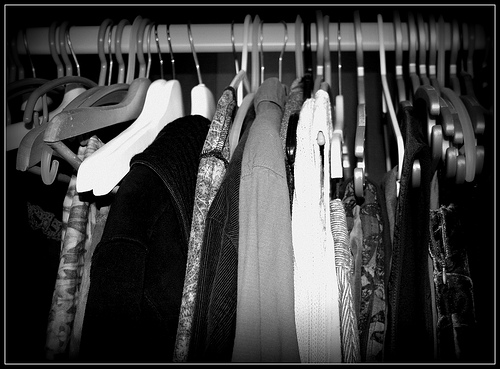
My approach to living a greener life involves small steps or goals. I live off-the-grid, grow a lot of my own food organically, and use only natural products.
Examining one’s life for the next step towards a greener existence, whether small or large, then taking action towards that move is the easiest way to make personal change.
For awhile, my challenge was remembering my reusable shopping bags. I have that one down. I can’t do much abut my gas guzzling SUV, as I live where 4WD is required and there is not an EV alternative yet. One area I have been thinking about a lot lately and do need to work on is clothing.
I have too many clothes. My kids have too many clothes. I love bargains. I love thrift stores. I love shopping for used clothing on ebay. I love sales. I love organic clothing. There, I said it. Our closets and dressers are overflowing. I could not possibly wear all of the clothes I own. I am like most westerners.
A story posted on Slate.com last Monday got me thinking about fashion. It was an expose on what happens to the clothes we donate to thrift stores:
What American doesn’t have something hanging in his or her closet worn only once or twice, a pair of pants waiting for a diet, or even a brand-new dress or jacket with the tags still on? Common sense and everyday experience tell us that we have so many clothes that a majority go underused and neglected. According to a 2010 national survey in ShopSmart magazine, one in four American women own seven pairs of jeans, but we only wear four of them regularly. Not surprisingly, charities regularly see brand-new clothes come in with tags still affixed. “We see people throwing away new stuff every day,” Maui says.
There is an enormous disconnect between increasing clothing consumption and the resultant waste, partially because unworn clothes aren’t immediately thrown out like other disposable products. Instead, they accumulate in our closets or wherever we can find space for them. Master closets now average about 6 feet by 8 feet, a size more typical of an extra bedroom 40 years ago.
Slate.com continues:
Most Americans are thoroughly convinced there is another person in their direct vicinity who truly needs and wants our unwanted clothes. This couldn’t be further from the truth. Charities long ago passed the point of being able to sell all of our wearable unwanted clothes. According to John Paben, co-owner of used-clothing processer Mid- West Textile, “They never could.”
There are thousands of secondhand textile processors in the United States today, mostly small family businesses, many of them several generations old. I visited Trans- Americas Trading Co., a third- generation textile recycler in Clifton, N.J., which employs 85 people and processes close to 17 million pounds of used clothing a year. Inside Trans-Americas, there is a wall of cubed-up clothing five bales tall and more than 20 bales long. “This is literally several hundred thousand pounds of textile waste, and we bring in two trailer loads of this much every day,” Trans-Americas president Eric Stubin told me. The volume they process has gone up over the years alongside our consumption of clothing…
Most of our donated clothing does not end up in vintage shops, as car-seat stuffing, or as an industrial wiping rag. It is sold overseas. After the prized vintage is plucked out and the outcasts are sent to the fiber and wiping rag companies, the remaining clothing is sorted, shrink-wrapped, tied up, baled, and sold to used-clothing vendors around the world. The secondhand clothing industry has been export-oriented almost since the introduction of mass-produced garments. And by one estimate, used clothing is now the United States’ number one export by volume, with the overwhelming majority sent to ports in sub-Saharan Africa. Tanzanians and Kenyans call used clothing mitumba, which means “bales,” as it comes off the cargo ships in the shrink-wrapped cubes like the ones I saw at Trans-Americas and Salvation Army. The bales are cut open in front of an eager clientele and buyers, who pick through it for higher-value finds.
Once again, while many Americans might like to imagine that there is some poor, underdressed African who wants our worn and tattered duds, the African used clothing market is very particular and is demanding higher quality and more fashion-forward styles. Paben told me that access to the Internet and cellphones has made the continent fiercely fashion-forward in recent years. “There’s been a change in what you can sell there,” he says, and the bales have to be much more carefully sorted based on style, brand, and condition. As incomes rise in Africa, tastes become more savvy, cheap Chinese imports of new clothes flood those countries, and our own high-quality clothing supply is depleted, it’s foreseeable that the African solution to our overconsumption may come to an end. What then?
It is not just Americans that are overconsuming clothing. GreenBiz.com reports that “Brits toss $142 million in clothing after single wearing.”
When we honestly reflect upon our lives, we realize our eco sins. For this one, I am guilty as charged. I have been working on this one slowly only purchasing new clothing when it is sustainably grown and focusing on used clothing to fill my appetite for something new to wear. I am slowly weaning myself.
My daughter is a good reminder for me. She is constantly telling me, “Mom, you don’t need anymore clothes.” As annoying as that is, she is right. When I feel like I need a bigger closet and envy those modern homes with walk-ins, I know I have fallen for the capitalist consumption trap.
Love reading any article that talks about how to shop ‘ green’.